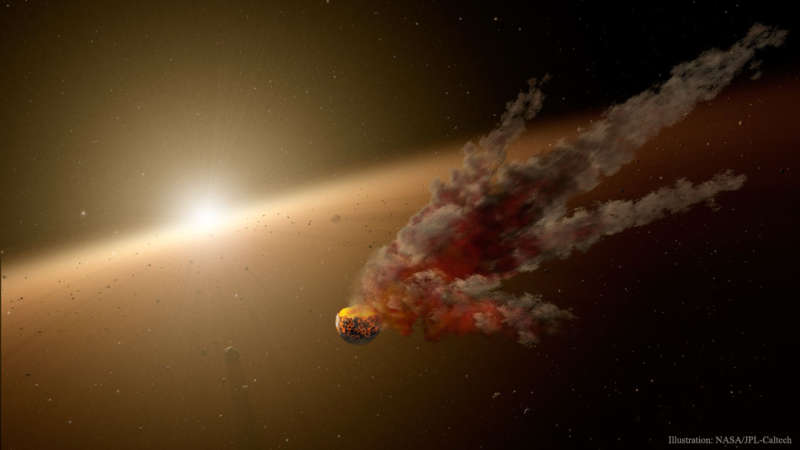Credit & Copyright: NASA,
JPL-Caltech
Explanation:
Why does star KIC 8462852 keep wavering?
Nobody knows.
A star somewhat similar to our Sun,
KIC 8462852 was one of many distant
stars being monitored by NASA's robotic
Kepler satellite
to see if it had planets.
Citizen scientists
voluntarily co-inspecting the data along with computers found this unusual case where
a star's brightness dropped at
unexpected times by as much as 20 percent for as long as months --
but then recovered.
Common reasons for dimming -- such as
eclipses by
orbiting planets or stellar companions --
don't match the non-repetitive nature of the dimmings.
A currently debated theory is dimming by a cloud of comets or the remnants of a shattered
planet, but these would not explain data indicating that the star itself has become
slightly dimmer over the past 125 years.
Nevertheless,
featured here is an artist's illustration of a planet breaking up,
drawn to depict
NGC 2547-ID8,
a different system that shows
infrared evidence of such a collision.
Recent observations of
KIC 8462852
did not detect the infrared glow of a closely orbiting
dust disk, but
gave a hint that the system might have such a disk farther out.
Future observations are encouraged
and
creative origin speculations are sure to continue.
1999 2000 2001 2002 2003 2004 2005 2006 2007 2008 2009 2010 2011 2012 2013 2014 2015 2016 2017 2018 2019 2020 2021 2022 2023 2024 2025 |
Yanvar' Fevral' Mart Aprel' Mai Iyun' Iyul' Avgust Sentyabr' Oktyabr' Noyabr' Dekabr' |
NASA Web Site Statements, Warnings, and Disclaimers
NASA Official: Jay Norris. Specific rights apply.
A service of: LHEA at NASA / GSFC
& Michigan Tech. U.
|
Publikacii s klyuchevymi slovami:
star - variable - zvezdy
Publikacii so slovami: star - variable - zvezdy | |
Sm. takzhe:
Vse publikacii na tu zhe temu >> | |
